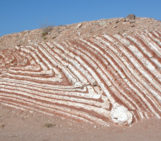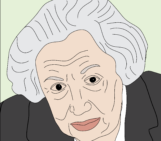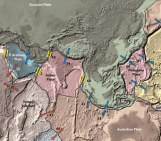

Women in Tectonics and Structural Geology by Lucia Perez-Diaz
Franciszka Szymakowska was born on the 5th of February in 1927 in Krakow. She was lovingly known as “Niusia” (Antoni 2007). About her early life, not much is known. Franciszka did her studies at the Faculty of Mathematics and Natural Sciences of the Jagiellonian University and graduated in 1952. During her studies, she started to work at the Polish Geological Institute. She remained affiliated with this institute until her retirement in 1997.
Early in her academic career, Franciszka investigated the stratigraphy of the Carpathians. Her first study was on the Krosno beds, a rock formation in the Carpathians, which she investigated at an incredible level of detail. The study was published in 1959 (Szymakowska 1959). In the decade that followed, she published multiple studies on the stratigraphy in the Central Carpathians. For her studies she went to rural areas in southern Poland and travelled to Ukraine to study the Silesian Serra Senon formation in the area of Kobyl (Szymakowska 1964). One of her talents that were recognized very early on in her career were her drawing skills. She was able to capture the most complex geological feature in very accurate and detailed images.

Geological and geomorphological map of the Gorlice area drawn by Franciszka (credit Szymakowska 1979).
Until the day of her doctoral promotion, on the 18th of February 1971, Franciszka had already published multiple single first-author articles and she had been involved in many collaborative studies, for which she mainly worked on the stratigraphy. A number of geological maps of southern Poland, she had already produced by then. She wrote her doctoral thesis ‘Geological structure of the Silesian and Podlasie units between Wola Brzosteck-Baczalowka from the north-west and Weglowka from the south-east’ (Szymakowska 1971), under the guidance of Marian Książkiewicz at Jagiellonian University in Krakow.
Shortly after her doctoral defense, in 1973, Franciszka became an Associate Professor in the Carpathian Department of the Polish Geological Institute. She was also an active member of the Geological Society of Poland. She would organize scientific sessions, and also contribute scientific material herself, both at national conferences and internationally. Her work on the Carpathian-Balkan system was significant and greatly appreciated. In 1979 she was honored as the best worker of the Geological Institute (“Zasluzony Pracownik Instytutu Geologicznego”) and in 1981 she was awarded the best Geologist of Poland (“Zasluzony dlaPolskiej Geologii”).
Franciszka fully experienced how the scientific theory of plate tectonics changed the playing field in geosciences. It is therefore not surprising that she started to integrate a tectonic understanding in her work. One of her first publications about geological structures explains the geology of the southern limb of the Gorlice fold and its tectonic origin (Szymakowska 1979). Other studies would follow, all accompanied with detailed, comprehensible drawings.
Franciszka is best remebered for her very detailed geological maps. During Franciszka’s time, most geological images in general as well as geological maps were drawn with pencils and colours by hand. Her graphical talent allowed her to produce clear, detailed and beautiful images that accompanied her work. They are one of the reasons why her maps are still used today, decades after they were made. Even until after her retirement on the 28th of February 1997, colleagues would rely on her steady hand and drawing skills for technical drawings of geological surveys and maps and she has been acknowledged for this in scientific contributions endlessly.
A few years after her retirement, in 2000, she married Krzysztof Birkenmajer, a geologist from the Jagiellonian University. They would travel together and meet the many friends Franciszka made during her numerous trips abroad, especially in former Yugoslavia. She would go and visit the seaside every year, and go to the beaches of Jadran for a swim (Birkenmajer 2011). Franciszka was known as a kind and smiling person, even though she had to overcome many hurdles during her life. She would never complain about her duties, and she always managed to combine field work and private life, spending time with her loved ones. She loved animals more than everything and she was known to save frightened animals from horrible living conditions.

Francizka Szymakowska-Birkenmajer and Krzysztof Ludwik Birkenmajer on their wedding day in 2000 (credit Birkenmajer 2011).
Towards the end of her life, the geological maps that she drew became part of a collective Polish geological mapping effort to make the Geological Map of Poland on a small scale (1:50000). Her maps were included for the areas covering the Polish Carpathians, including the regions of Osielec, Sucha, Kalwaria, Zebrzydowska, Pilzno, Frysztak, Jedlicze. The collaborators on the map greatly relied on her drawing skills as not only the maps, but also the accompanying cross-sections were drawn by Franciszka. Between 2001 and 2005 she occupied herself with the drawing of a clean, coloured geological map of Poland, which would result in 11 different sheets. Unfortunately, Franciszka passed away in 2007, and she has not seen her map in its full glory. Initially, the map could not be printed at the size it had been drawn. For this reason, the map was first printed at a 1:10.000 scale. Only in 2014-2016 were the final efforts made to print Franciszka’s map at its original scale (1:5000).
Franciszka made a significant contribution to the development of Carpathian geology. She didn’t manage to write her complete comprehension of the Carpathians as she understood it. She left an unfinished study summarizing her work on the tectonics of the central part of the Polish Carpathians. What remains is the rich field material that is preserved in the form of hand-made drawings of stratigraphic columns, cross-sections and geological maps. Her excellent drawing skills, her astounding geological knowledge and her passion for her field, proved the golden combination for Franciszka to unravel the complexity of Carpathian Geology.
References
Wójcik, Antoni. “Kronika Polskiego Towarzystwa Geologicznego-Franciszka Szymakowska-Birkenmajer (1927-2007).” Annales Societatis Geologorum Poloniae. Vol. 77. No. 2. 2007.
Szymakowska, F., 1959. Rozwój warstw krooenieñskich w niektórychobszarach Karpat OErodkowych. (In Pol ish, Eng lish summary). Kwartalnik Geologiczny, 3: 620–637.
Szymakowska, Franciszka, and Janina Morgiel. “Margle fukoidowe senonu serii śląskiej w Kobylu.” Annales Societatis Geologorum Poloniae. Vol. 34. No. 3. 1964.
Szymakowska, Franciszka – Budowa geologiczna jednostki slaskiej i podslaskiej miedzy Wola Brzostecka-Baczalowka od polnocnego zachodu a Weglowka od poludniowego wschodu. Promotion date: 18. 02. 1971 r., Promotor: prof. dr hab. Marian Ksiazkiewicz
Szymakowska, Franciszka. “Budowa geologiczna południowego skrzydła fałdu Gorlic między Gorlicami a Krygiem (Karpaty środkowe).” Annales Societatis Geologorum Poloniae. Vol. 49. No. 1-2. 1979.
Birkenmajer, Krzysztof Ludwik. “W kraju iw świecie (kartki z życiorysu).” Analecta. Studia i Materiały z Dziejów Nauki 20.2 (2011).





Harrison
Useful information